There are a variety of technologies and methods used to test the insulation of wire and cable, including high-potting, very low frequency (VLF), power factor, partial discharge, time-domain reflectometry (TDR), and “thumping.” Like a visit to the doctor’s office, each test examines the test item in a different way and looks for a different response from the insulating material. Which test(s) and how many to employ is a judicious decision to be made by a skilled technician. This article will focus only on the most basic and fundamental test, insulation resistance. There is still debate among industry professionals regarding the value of testing, when and how often, what techniques and voltages to employ, and so on. Differing opinions and advice are available in the literature. This article is based on the acceptance of testing as being of fundamental value.
Certainly the most widely used and general test, the insulation resistance test puts a (comparatively) high voltage across the insulating material, measures the amount of current that flows, and simply employs Ohm’s Law to convert these two bits of critical data to resistance. By definition, insulation is to retard the flow of current so that it continues through the circuitry as intended and nowhere else, such as to ground or through a person. But no insulation is perfect and can stop all current. A convenient way to think of this is to picture a lightning stroke. Air is a good insulator. In fact, there exists electrical equipment that is air insulated. But when enough of a voltage gradient develops between the clouds and the earth, a current flow occurs, in a most dramatic manner! The “infinity” reading (∞) familiar to operators of analog testers is not meant to signify that the insulation resistance is in fact “infinite.” It merely indicates that it is beyond the measurement range of the tester, whatever that might be.
The Megohmmeter

A calculator and Ohm’s Law can readily provide an appreciation of the magnitudes involved. Once leakage current reaches the milli-amp level, the material is starting to look more like a semi-conductor than an insulator. At system voltages, about 5 mA is generally regarded as a shock level to the human body. So the demand on the insulating material is quite pronounced and the tester needs to provide only a small amount of current before the insulation isn’t truly insulation anymore. Since most tests are performed on more or less good insulation, however, a high voltage is required in order to effectively exploit the condition of the material and provide a reliable indication. Left unnoticed and unchecked, these small leakage paths will continually enlarge and eventually short circuit the equipment.

Test Voltage
Downstream of manufacturing, dc testing is performed for acceptance, installation, ongoing maintenance, troubleshooting and repair. Test voltage selection is largely at the operator’s discretion, but industry standard is to perform “as rated” and “twice rated” tests. For 600 V cable, it might be more practical to consider an “as rated” selection as being “around rated.” Sophisticated and more expensive models may have a 600 V selection, but most common testers have a 500 V test. This will do. For twice rated, again some practicality can be employed. Relatively inexpensive handheld testers typically top out at 1 kV. Again, this should suffice. Selecting a 1200 V test and higher requires a quantum leap to more expensive 5 kV instruments.
Table 1. Condition of insulation indicated by dielectric absorption ratios
As rated testing fits well with routine maintenance and record keeping. The cable’s resistance is measured at a voltage stress that approximates what it will experience during operation, and the number gives a useful indication of the cable’s overall condition. Twice rated is useful for troubleshooting. Insulating material that is generally deteriorated, as by water or age, will reflect this condition at virtually any test voltage. So an as rated test will reflect general contamination as a notably lower reading than from previous tests or expectance. But otherwise good insulation can have localized damage spots, such as a break caused by a bend in conduit or a pinhole from a voltage spike going to ground. These are prime causes of the devilish intermittent faults. The circuit works, and then it doesn’t, and then it does. No instrumentation or procedure can unerringly identify intermittents on the first shot. They can be hard to spot. But a higher test voltage is one way. It may be enough to pull an arc to conduit, for instance. Test voltages can be further increased beyond the most common twice rated, and doing so may reveal problems that have so far been missed. But this process must be balanced against maximum voltage the cable can take. Remember, the tester is applying a constant voltage, not a spike.
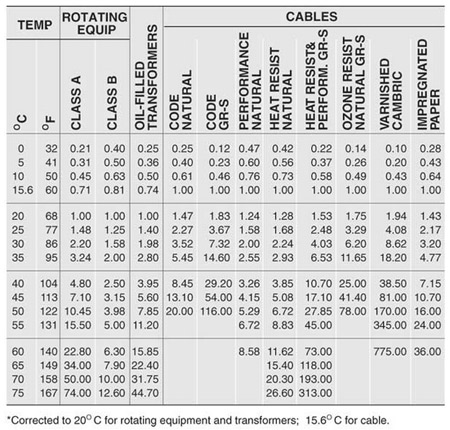
Test Hookup
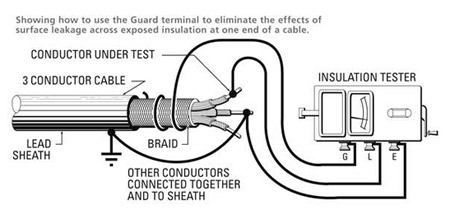
Figure 3. Guard 1
Circuitry-to-ground tests are a quick way to get a measurement of the overall cable condition. The more load that is put on a test, the lower will be the readings, as there will be more insulating material to pass leakage current. If three phases are combined and tested to ground, the reading will be lower than if each were tested individually. If the reading is satisfactory, such a test saves time. If not satisfactory, then more time can be invested testing each phase individually and to each other. To accommodate the jaws of the test clips, phases can be connected together by bare wire, and a variety of pigtails and flexible sheaths will adjust for different gauges. The all-in-one test is a convenient way to obtain routine maintenance test results; while for troubleshooting a known or suspected problem, the more specific tests are preferable. Also, remember to include cable length. Resistance varies inversely to length and in direct proportion. The more material, the more leakage, and the lower the reading. Two circuits of the same wire, with similar usage and age, might be expected to be reasonably comparable. If one reads markedly lower, it could be a sign of an incipient problem. But if it is twice the length, the readings are essentially equivalent.

Figure 4. Guard 2
Guard Terminal
An additional capability of many megohmmeters is the use of a guard terminal. This is a third terminal, typically marked with a “G.” Do not confuse this with “ground,” as in a safety ground. Doing so will not cause harm, but will defeat the purpose of the test. A guard acts as a shunt. In the presence of multiple parallel leakage paths, it directs the current in one or more paths around the measurement module, so that only the leakage through the unguarded path is measured. The most fundamental use of the guard in cable testing is to eliminate surface leakage at terminations. When a megohmmeter is connected to a termination — say, conductor to sheath — current will track across the surface from one alligator to the other. The dirtier or moister the surface is, the more current and the lower the measurement. However, this may not be the measurement the operator wants. It indicates something about the termination, and if cleaned and/or dried, the reading may notably rise. But the condition of the insulatingmaterialdepends on leakagethrough, notover, the insulation. The guard enables a reading of just this parallel path. By wrapping a bare conductor around the cable between the two test clips, current traveling across the surface is intercepted and taken out of the measurement. The reading will rise, and the extent of the rise is an indication of the surface condition at the termination. Surface leakage should not be disregarded, however. It too will promote burn tracks, and efforts can be made to minimize it. This technique can be extended to eliminate any parallel leakage from a measurement. Surface leakage can be eliminated from both ends of a cable, and leakage to other conductors while the resistance between any two conductors is measured. By focusing the test on a specific pair of conductors, the guard adds the ability to sectionalize the cable simply by switching terminals. Be sure to check the accuracy of the guard, however. Testers engineered for low cost tend to take short cuts with the guard, and as a result, may introduce considerable error into the reading.
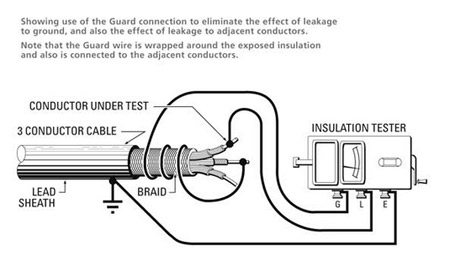
Figure 5. Guard 3
Progress of Test
To the uninitiated operator, the most confusing part of insulation testing is the travel of the analog pointer and the instability of digital readings. Testers typically rest at the high end of the scale, so that upon initiation of a test, the pointer will peg sharply to the low end and digital readings will start low. The pointer will then drift back toward its rest position while digitals will continue to rise. This is because the cable is charging. Current flow is actually composed of three distinct elements. Because conductors are in parallel, separated by insulation, they act as a capacitor and draw a charging current. At the same time, the insulating material itself polarizes molecularly under the influence of the voltage field. This constitutes a movement of charge, hence a current, and is called absorption current. Capacitance charges quickly and accounts for the initial sharp pointer peg. Because absorption is occurring in insulating material, a poor conductor, it takes much longer, and accounts for the steady rise of analog pointers and digital numbers. So when is the reading “correct”?
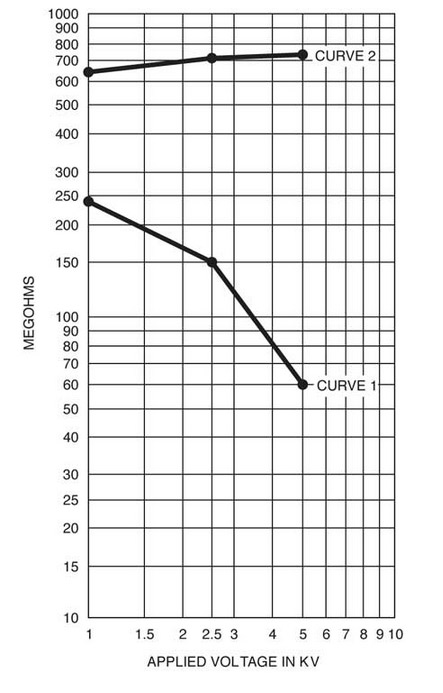
Figure 6. Test curves by the step-voltage method, comparing results with good and bad insulation
All the readings are correct, for that specific time of test. But the operator is looking for insulation condition, which is a factor of the third component, leakage. This is what remains flowing after all charging has become complete. Why not just wait until then? The problem is twofold: time and recognition. The bigger the test item, the more capacitance, the more absorption, and the longer it will take to come to full charge. This could beprohibitivelylong, even hours. Moreover, the resistance rise will slow down so that it becomes like a clock hand, moving but not visible. Therefore, the amount oftimethat the test was run should always be included in reports and for repeat or followup tests. The same cable run tested for thirty seconds may read decidedly lower than at sixty seconds, and if not taken into account could lead to wrong conclusions. Additionally, pointer travel should besmooth. Veteran personnel often look only at travel. Smooth travel indicates even charging. An erratic pointer indicates arcing, moisture vaporizing off, or some other problem. Digitals aren’t as easy to read in this regard, but steadily rising numbers are what should be seen. The display will update numbers according to the sampling rate, and these should reflect continuing rise. With high-quality instruments, learn to look for the unit of measurement, not just the number. These models may autorange from megohms to giga-ohms or even tera-ohms (MΩ, GΩ, TΩ symbols).
Interpreting Readings
Once a reading is obtained, is the job done? No. The reading still has to be interpreted, and that could be the hard part. It’s not like, say, voltage measurement. It’s supposed to be 120, but could be perhaps 115 or 123; it’s NOT going to be 5 mV or 20 kV! But insulation testing spans an enormous range of possible measurements. This requires some adaptation in the evaluation process. The most recognizable “rule” is the One Megohm Rule, stating that there should be at least one megohm for every kV of rated voltage, and never less than one (for 120, 240, 480, etc.). This guideline is very forgiving, however, and doesn’t imply much more than that the circuit will turn on without tripping breakers, starting a fire or causing a shock. It may not run for an acceptable time.
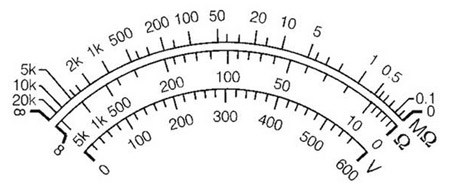
Figure 7. Typical scale
By far the most reliable reading is one that compares favorably to a previous test. Over time, insulation will deteriorate from the ingress of corrosive materials and moisture, electrical stresses from startups and line disturbances, mechanical stresses from vibration, and a host of other damaging influences. Eventually, breakdown and failure will occur, but this could be a very long time — or not so long. Accordingly, insulation readings act like the odometer on a car, but in reverse. They start high upon installation and drift downward over time. Or there can be catastrophic failure, as from flooding, fire, or voltage spikes and surges such as from lightning strikes. Test readings fix approximately where the cable is on a life cycle, and comparison of successive readings then can establish the duration of that cycle.
Very high readings could nonetheless be falling rapidly due to the effects of some damaging factor, like exposure to excessive moisture. A reading that isnotespecially high could be due to an evenly distributed leakage throughout the body of the material that may not be deteriorating and may hold its value for years. But previous results are often not available. Accordingly, standard test procedures have been established that help to deal with both the problems of test time and interpretation. Taking a single measurement, as previously described, can be referred to as a Spot Reading Test. This test has the limitation of providing a single number that must be evaluated, and is also influenced strongly by temperature. Insulation readings typically are cut in half by a 10° C rise, so this effect is quite pronounced. Different materials have published correction factors, and readings should be corrected to a common temperature. As previously mentioned, thetimeof the test should also be standardized. Humidity can play a role as well, but this is not directly quantifiable and should only be regarded as a possible factor in anomalous readings. Once these corrections have been made, there remains a number, which is reliable but still calls for evaluation.
Test Methods
A self-contained test that provides for automatic evaluation is the long-standing Polarization Index (PI) test. In this, a one-minute reading is divided into the final reading of a ten-minute test. This procedure addresses both the problems of time and interpretation. It is useful for long runs where capacitance is high and readings may continue to rise for considerable time. If the reading at ten minutes is notably higher than at one, it indicates that most of the current is charging current, not leakage, because leakage is constant for a given voltage (just as a circuit will pass the same current as long as the voltage is stable) and will hold the final reading down. The operator is freed from the numbers and just looks at the ratio; the higher, the better. This concept is extended to the Dielectric Absorption Ratio test, which is just a polarization index performed at other time intervals. Newer materials are producing higher initial readings (now into the tera-ohm range) and shorter absorption times, so that ratios like one minute to three, and even thirty seconds to one minute, may be sufficient to provide an evaluation.
Another standardized procedure with a built-in interpretation is the Step Voltage Test. Here, instead of time, the applied voltage is manipulated. Industry standard is to increase voltage in one-minute intervals for five minutes. But a variation to accommodate the available voltages on a particular instrument can still give valuable results. Healthy insulation is uniform and will stand up to increases in voltage. But when deteriorated, each increase will pull leakage through additional flaws, and readings will drop notably each time. This test is particularly good for spotting localized damage, as something like a pinhole will suddenly arc when the appropriate voltage is reached. In addition to these standard tests that provide their own interpretation, results can also be evaluated against manufacturer’s specs (although frequently hard to obtain), standards recommendations from independent agencies, or comparison to similar circuits (but remember to allow for length).
A roomful of engineers may argue all day, and testing of cablecanbe harmful if improperly conducted. But a reliable body of information exists to describe procedure and interpretation. Performed accordingly, cable testing is a valuable tool of electrical maintenance.
Safety
Despite their high voltage, well-designed megohmmeters are not lethal instruments. Only a small amount of current is available, typically a few milli-amps. Current is limited because insulation will accommodate very little while remaining insulation. Above a few milli-amps, the material isn’t insulating anymore. Limited current limits the “danger” posed by the testers, making them subject to use in practical jokes. This practice is discouraged by all reputable manufacturers.
But while the tester is a safe instrument, the testitemcan be lethal! For safety evaluation, make sure to distinguish between the tester and the test. The tester may be designed with maximum safety features but there is no such control on the equipment to which it may be connected. Possibly the greatest danger comes from stored charge on the test item. Because megohmmeters apply a dc voltage, they will charge the capacitance and absorption capabilities of the test item. This can produce considerable static charge, even lethal. Items with large windings or long runs of cable are especially dangerous. The item under test (IUT) therefore must be effectively discharged before it is touched at the completion of a test. Testers years ago came with a discharge switch, but modern units do this automatically. Having to engage a switch invites human error. At the conclusion of a test, a resistive discharge network in the tester automatically bleeds off static charge and a voltmeter function monitors it so that the operator knows when it is safe to approach the IUT.
With older models, there was more human involvement. An accepted rule of thumb was that it took about four times the duration of the test to complete the discharge. In the interest of time, this process can be speeded by applying a resistive discharge stick, or sticks. These devices are insulated poles of high dielectric constant containing a resistor network. A ground clamp is attached to an appropriate ground while a metal hook on the other end makes contact with the item to be discharged. Upon completion of the accepted discharge time, a second hook, farther down the handle, is applied so as to create a dead short. This is left in place while permanent ground connections are applied, as the IUT can dangerously recharge itself by molecular realignment of the insulating material. Never attempt to discharge by applying a dead short. Dangerous sparking can occur and high frequency feedback can damage the IUT.
A danger can also occur though accidental connection to a live system or through an IUT’s becoming energized while a test is in progress. Older testers sometimes had a voltmeter selection, but again, this can be overlooked through human error. Modern instruments have an automatic voltage warning. If someone closes a switch while a test is in progress, or a fault occurs on the line, the tester should immediately issue visual and audible warnings, and the actual voltage measurement may also be displayed. Insulation tests arenevermade on live equipment. [Be sure to adhere to industry-standard lock-out/tag-out procedures.] In addition to threatening the operator, live external voltage also can damage the megohmmeter. Older models were regularly “cooked” by careless operators who disregarded external voltage and applied the test. Well-designed units now have inhibition circuits that keep the unit protected. For maximum safety, these protections should still operate despite blown fuses.
Finally, operators should always be aware of IEC61010-1 category ratings against arc flash and arc blast. These ratings establish the ability of the tester to withstand internal arcing in the event of a voltage spike due to a disturbance or fault on the line being tested. The tester should be appropriately rated for the electrical environment in which it is to be used.
Don’t overlook the testarea. No one should be able to touch the IUT while the test is in progress. Appropriate barriers and warnings should be in place. Watch out for anything leading away from the area, such as conduit, that might somehow become live and present an energized metallic surface to passersby. Remote parts of the system may become energized; keep the other end of circuits isolated and disconnect equipment. Also, examine the test leads, making sure they are in good condition. Leads with high leakage due to poor quality or wear will distort results and can also present a safety hazard.Be sure to BOTH review the safety features of the instrument AND establish a safe procedure before going ahead with the test. The instrument cannot guard against all possibilities with a careless or untrained operator, while the most skilled personnel are still at risk with a poorly designed tester.










Find Us on Socials